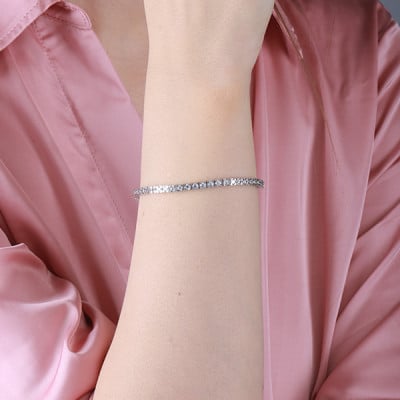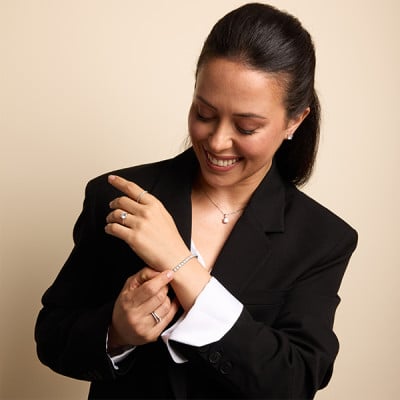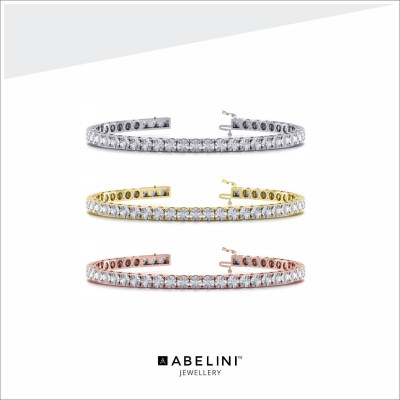Ultimate Guide On How To Buy A Bracelet?
Bracelets are a fantastically versatile piece of jewellery that provide a perfect accent for any outfit and all occasions. Yet, with so many to choose from, how do you select the perfect bracelet for you or your loved one?
In this comprehensive guide, Abelini’s team of passionate jewellery experts share their insights into every detail to consider when searching for a new bracelet.
From bracelet types, styles and materials to clasps and closures, sizing and fit and even maintenance – settle in for a fascinating exploration of the world of beautiful bracelets.
Once you’re done, make sure you check out our full range of bracelets – and, if you’d like some personal advice from our friendly staff, we’re ready and waiting for your call.
What Do Bracelets Symbolise?
Of course, some people simply wear bracelets because they like the way they look and feel. However, there is sometimes also some symbolism behind this popular item of jewellery.
The circular shape of a bracelet can symbolise infinity, making it a particularly meaningful gift for a loved one. Bracelets throughout history have been worn for all sorts of reasons: to encourage the winter to end and the spring to arrive, to ward off evil, or to demonstrate marital status. Bracelets can also be a way to demonstrate a cause you're interested in or something you're passionate about, from simple charity bands to ornate charm bracelets.
Abelini’s Ultimate Guide On How To Buy A Bracelet?
There are many specifics to consider when searching for the perfect bracelet to purchase. Use this guide to consider every potential feature of your ideal bracelet, so you can narrow down your search and focus on selecting the most brilliant example for your unique needs.
1. Types of Bracelet
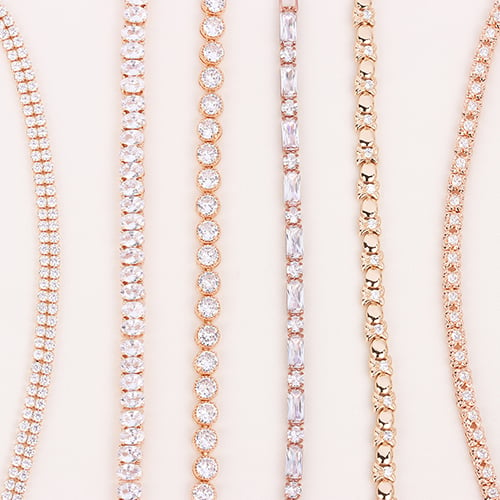
The first point of consideration are the main styles of bracelet available – from classic bangle bracelets and precise tennis bracelets to rustic leather bracelets and unique wrap bracelets, each bracelet type comes with its own history and styles that it favours.
Bangle bracelets feature a circular, rigid band with no closure. Popular throughout history – especially in African and Indian culture – bangle bracelets are timeless in style and elegant in their simplicity. Due to their lack of closure, sizing is important when buying a bangle bracelet.

Tennis bracelets are popularly known for their small, closely set gemstones in a single, continuous line. Elegant and delicate, the “tennis bracelet” name originates from the 1987 US Open when Chris Evert's diamond bracelet broke and the match was paused until she could find it.
Delicate bracelets (including tennis bracelets) are known by their fine, slimline design, often featuring a thin chain of small gemstones and other decorative elements. Chosen for their understated class, delicate bracelets are incredibly versatile when it comes to outfit pairing.

Cluster bracelets feature gemstone groupings in specific patterns or shapes, which can then be combined with other decorative elements in visually striking clusters. Bold and eye-catching, cluster bracelets are great for those seeking to make a declaration.
Beaded bracelets feature series of beads strung together – whether made from gemstones, pearls, wood, glass or plastic. Beaded bracelets are often simple, casual and cool, though extravagant beaded bracelets may feature complex beadwork or patterns.
Charm bracelets feature bracelet chains adorned with charms and pendants that evoke memories for the wearer or giver, or represent personal interests. They are customisable in nature, with charms that can be continually added or swapped for a truly custom, ever-changing look..
Cuff bracelets are rigid and wide, most often metal and designed to encircle the wrist partially. Whether simply sleek or intricately decorated with gemstones, cuff bracelets make for loud fashion statements and work well when stacked with other bracelets.
Friendship bracelets are most-often handmade, created using colourful fabric threads then gifted to one another as a symbol of a strong friendship. Intimate and personal, friendship bracelets may then be adorned with charms that represent key points in a friendship.
Wrap bracelets feature a continuous, flexible strand wrapped multiple times around the wrist. Whether made from leather cords, fabric, beads or chains, wrap bracelets are endlessly versatile and make an ideal choice for bracelet wearers who favour adaptable accessories.
Ultimately, the personal style of the wearer will provide the best guidance when selecting the ideal bracelet type. At Abelini, we feature a comprehensive range of bracelet types to suit the needs of every wearer – and are ready to provide you with personal advice in your bracelet buying journey.
2. Bracelet Metals & Materials
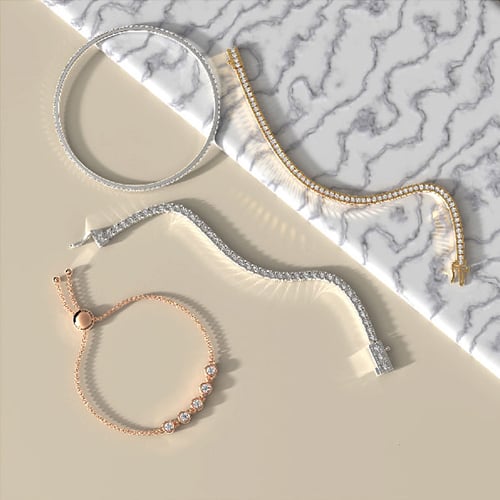
Each bracelet metal and material features unique benefits that contribute to the styles of bracelet created using them. Choose from a range of popular metals as well as alternative materials for bracelet construction.
Yellow Gold is a classic choice for bracelet construction. Resistant to the knocks and drops of daily wear – as well as against corrosion – it’s no surprise why yellow gold bracelets are so popular.
White Gold is another iconic metal for bracelets, with the brilliant finish achieved by alloying yellow gold using nickel, zinc or palladium – just remember that occasional re-plating may be needed to maintain the finish of a white gold bracelet.
Rose Gold has grown more popular in bracelet construction throughout recent years, thanks to its pink hue that complements many skin tones and makes for romantic, trendy bracelet styles.
Silver is a versatile bracelet material thanks to its malleable quality, which supports high creativity in design. From simple, silver bangle bracelets to delicate silver princess bracelets, this metal is a popular choice for its eye-catching shine and durable nature.
Platinum is a quality bracelet material for those seeking gold bracelet alternatives. Costly yet striking, this durable metal is naturally white, requires no plating and has hypoallergenic qualities that make it ideal for bracelets for sensitive skin.
Stainless Steel bracelets are known for their durability and resistance to tarnishing, making them a popular choice for everyday wear. Their modern appearance complements casual and formal outfits alike, while a polished or brushed finish provides the perfect accent for a sophisticated look.
Titanium bracelets are incredibly light, strong and corrosion-resistant, delivering a contemporary vibe through often-minimalist designs. Their hypoallergenic qualities make titanium bracelets a great choice for sensitive skin – while a vast variety of matte, polished and textured finishes opens doors to creative pairing.
Leather bracelets bring a rustic, casual aesthetic that suits dressing up and dressing down alike. The natural patina of leather that develops over time means your leather bracelet will gain personality as you continue wearing it. Leather bracelets can often be paired with metal bracelets for an eclectic stacking look.
Gemstone and Crystal bracelets are popular for their vibrant, natural colours using gemstones like diamond, ruby, sapphire, emerald or semi-precious stones like amethyst or turquoise. Often featuring spiritual relevance, gemstone and crystal bracelets enrich any outfit with personal significance and unique style.
Wood, Bone and Other Natural Material bracelets offer an earthy, organic appeal – whether carved, polished or combined with other materials to create unique designs, natural material bracelets are lightweight, comfortable and rich with bohemian style.
Synthetic Material bracelets may be made from resin, acrylic or plastic formed into an endless range of patterns and shapes. They may mimic natural materials or celebrate their synthetic nature, permitting experimental bracelet styles. Synthetic material bracelets are a popular choice for fashion-forward individuals, as well as those who champion cruelty-free products.
No matter the bracelet metal or material you choose, you can be sure that Abelini will have a selection of excellent designs to meet your personal aesthetic needs.
3. Bracelet Clasps and Closures
A bracelet is only as good as its clasp or closure – and with many iconic bracelet clasp and closure styles are available, you can select one that suits your style, convenience and security.
The Lobster Clasp is one of the most common and reliable bracelet clasp types, featuring a small, spring-loaded mechanism that opens and closes whenever a lever is pressed. Lobster clasps are easy to use yet secure, versatile and suitable for all bracelet styles – from delicate tennis bracelets to large cluster bracelets.
The Toggle Clasp features a T-shape bar inserted into a circular or decorative loop. The toggle clasp adds an extra design element to the bracelet and may even be a focal point of the bracelet itself. Easy to fasten yet still secure, toggle clasp bracelets are popular with those seeking a convenient bracelet wearing experience.
The Spring Ring Clasp is a small, circular clasp with a spring mechanism. It features a tiny lever to pull back in order to release and secure the bracelet. Due to their sensitive, sometimes fiddly nature, it is no surprise that spring ring clasps feature mostly in lightweight, delicate bracelet designs.
The Box Clasp consists of a metal box with a small latch and metal tab that fits into the box to secure the bracelet. Box clasps offer secure, elegant closure and are mostly found in high-end, formal bracelets. Seamless when closed, the box clasp often becomes part of the design of the bracelet itself.
The Slide Lock Clasp features a clasp in which one end of the bracelet slides into a locking mechanism on the other end. A streamlined, modern closure, side lock clasps are used in many contemporary bracelet designs – easy to use yet secure, they often feature in leather, metal or beaded bracelet designs.
The Magnetic Clasp uses magnets to connect the two ends of a bracelet, providing a high level of convenience that suits those with lesser mobility or who struggle with fiddly traditional clasps. Designed well, a magnetic clasp can provide remarkable strength – so should not be avoided for fear of coming undone unexpectedly.
The Hook and Eye Clasp features a small hook that fits into an oval-shaped ring or eye. A simple, classic bracelet closure type, hook and eye clasps are often featured by bracelets of a traditional or vintage appeal – adding a subtle and understated touch.
The Knot or Adjustable Closures feature knots to be tied or mechanisms to be adjusted in order to secure the bracelet. Commonly found in bracelets of cord, string or leather, knot or adjustable closures provide a casual and bohemian vibe while offering fantastic adjustment of size for best comfort.
Each bracelet clasp or closure style presents its own functionality, aesthetic appeal and level of security. The choice you need to make depends on the type of bracelet, personal preference and desired style of the wearer. If you need help, we’re here to provide it!
4. Bracelet Shapes and Chains
Just as no two human wrists are the same, bracelets come in a range of shapes to best-suit the wearer. Bracelet shape is an important factor to consider when selecting a bracelet that will be as comfortable to wear as it is impressive to onlookers.
Round bracelets have a circular shape for a classic and versatile design. Comfortable to wear, round bracelets complement a fantastic range of outfits and styles, and are used popularly in bangle or cuff bracelet styles.

Princess bracelets feature a square or rectangular shape with sharp corners. Geometrically alluring, princess bracelets add a contemporary touch – whether used in sleek, minimal bracelet designs or adorned with gemstones to achieve a more glamorous princess bracelet.

Emerald bracelets have a rectangular shape with slightly cut corners, are known for their elegant and sophisticated appearance – and are often accompanied by emerald-cut gemstones for a cohesive themed design.
Oval bracelets have an elongated shape with rounded edges, which is known to provide a flattering, feminine look upon the wrist.
Marquise bracelets feature a distinct, pointed oval shape with tapered ends – a uniquely eye-catching design that creates the illusion of elongating the wrist. Marquise bracelets are often adorned with marquise-cut gemstones or diamonds.
Asscher bracelets have a square shape with cropped corners, similar to the emerald bracelet shape. Asscher bracelets offer a glamorous vintage aesthetic and are often set with Asscher-cut diamonds or gemstones for a cohesive design.
In addition to these bracelet shapes, you may also select from popular bracelet chain types, including:
Bead chains consist of small beads linked together to form a continuous chain. They deliver a dainty, delicate look, and are often used in charm bracelets or for showcasing small pendants.
Mesh chains are constructed from woven metal threads, which combine to create a textured, flexible appearance. Depending on the designer, mesh chain bracelets may be firm or loose – yet they are always unique and alluring.
Snake chains have a smooth, rounded surface that alludes to the texture of a snake's skin. Snake chain bracelets drape elegantly on the wrist, and are often paired well with pendants or as stand-alone pieces.
Byzantine chains feature intricately woven links that together create a dense, ornate appearance. They are luxurious and detailed in their design, and are most often seen in high-end bracelets.
Rolo chains are made up of symmetrical, uniform round links. Rolo chain bracelets provide a classic and timeless design that is suitable for a huge range of bracelet styles.
Venetian or Box chains consist of square-shaped links that are closely connected to provide a sleek, sophisticated look – they are often used in bracelets with pendants or as standalone pieces.
Cable chains have oval or round links connected in a simple and uniform pattern. They are sturdy and versatile, and suitable for a wide range of bracelet styles.
Rope chains feature twisted or braided links that unite in conjuring a rope-like texture. Their design is bold yet intricate, and adds inquisitive depth and visual interest to the bracelet.
Wheat chains are made up of twisted oval or teardrop links, providing a uniquely textured appearance that is suitable for delicate and chunky bracelet designs alike.
As you can see, there is an incredible amount of choice when it comes to selecting your bracelet shape or chain. Whether you are leaning towards a traditional shape or chain – which are often best for celebrating the presence of a pendant – the Abelini team are ready and waiting to help you.
5. Buying Bracelets as Gifts
Buying gifts for others can be intimidating at the best of times – and nothing is trickier than buying a piece of jewellery. The following tips will be useful in discovering the perfect bracelet for your loved one.
Selecting the right bracelet for different occasions
For a casual or everyday wear gift, consider a simple beaded or leather bracelet. These are versatile choices that can easily be dressed up or down.
For a birthday gift, consider a charm bracelet. You can add meaningful charms that represent the recipient's personality, hobbies or milestones – and they can add their own in the future.
For an anniversary gift, our customers mostly select a delicate gold or silver bangle bracelet featuring a meaningful inscription or the couple's initials. You cannot go wrong with this romantic, timeless choice.
For a graduation gift, why not select a sophisticated cuff or link bracelet featuring an engraved motivational quote or the graduate's initials?
For a a wedding gift, a pearl or diamond tennis bracelet can make a stunning and elegant gift for a bride or bridesmaid.
Tips for choosing a bracelet that suits the recipient's style
Take note of the jewellery they already wear – this will provide insights into their preference of bracelet material, as well as give an idea of their favoured bracelet styles and designs.
Personalize your gift by adding a monogram, initials or a meaningful charm that will make the gift far more personal – and show the recipient that you put a lot of thought into your gift.
Pay attention to wrist size to make sure that the bracelet will fit comfortably on the recipient's wrist. See above for our suggestions on how to discover wrist size without ruining the surprise of your bracelet gift.
Gift wrapping and presentation ideas
A jewellery box is a beautiful and elegant way to present your bracelet – choose a box that matches the style of the recipient as well as the style of their bracelet.
Include a personalized message expressing your sentiments and the reason behind choosing the specific bracelet.
And for an extra touch – why not add a small charm or trinket to your gift wrapping?.
Caring for Your Bracelets
If you look after your new bracelet it is sure to bring you many years of beautiful wear. Consider the following when caring for your bracelet:
Cleaning and maintenance tips
Regular Cleaning will prevent dirt and grime build-up. Use a soft cloth to gently wipe the surface of the bracelet – avoid abrasive materials or harsh chemicals that may damage the finish.
Avoid Water and Chemicals by removing your bracelet before swimming, bathing or engaging in any other water-based activity. Water can damage certain materials. Also, avoid exposing your bracelet to harsh chemicals such as perfume, lotion or cleaning agents that may tarnish or corrode metal bracelets.
Avoid Extreme Temperatures as they can cause damage to certain materials or affect the integrity of adhesives used in the bracelet.
Professional cleaning is worth having every year or so – here at Abelini, we have specialised tools and knowledge for cleaning your bracelet more thoroughly than is possible at home.
Proper storage solutions
Jewellery Boxes are great for storing your bracelets individually and keeping them from getting tangled up with or scratched by other jewellery pieces.
Soft Pouches or Bags are essential storage solutions for bracelets that are more delicate or prone to scratching. Soft pouches or bags made of fabric or velvet will provide extra layers of protection.
Avoid Moisture and Humidity, which can damage certain metals and other materials such as leather. Store your bracelets in a dry environment, away from direct sunlight and extreme temperature changes.
Anti-Tarnish Strips are essential for silver bracelets – store together to absorb potentially damaging moisture and to prevent tarnishing.
Repair and restoration advice
If your bracelet requires repair or restoration, it's best to consult one of our professionals here at Abelini rather than attempt a fix and damage your bracelet further. Here’s a few general tips to keep in mind:
Regular Inspections will uncover initial signs of damage, such as loose stones, broken clasps or weakened links. Addressing these issues promptly can prevent further damage.
Professional Evaluation by our team or an independent provider will bring to light any damage – if needed, you can then request a quote for resolving the issue.
Retain Original Components such as clasps or stones – if they need to be replaced, using original replacements will maintain the authenticity and value of your bracelet.
By keeping the above tips in mind, you can look forward to many delightful years with your bracelet looking and feeling at its best!
Faq
To determine the right size bracelet, it's essential to measure your wrist accurately. Using a flexible measuring tape or a strip of paper/string, wrap it around your wrist just above the wrist bone. Make sure it fits snugly but not too tight. You can then measure the length using a ruler. This measurement will help you choose a bracelet that fits comfortably.
A bracelet should fit comfortably on your wrist without being too tight or too loose. It should be snug enough to stay in place but not so tight that it feels constricting or uncomfortable. You should be able to move your wrist freely and easily slide a finger under the bracelet.
Neither too tight nor too loose is ideal for a bracelet. It should strike a balance between being comfortably snug and allowing some movement on your wrist. A bracelet that is too tight may feel restrictive, while one that is too loose may slide around excessively or risk falling off.
A general rule of thumb is to add about 1 inch (2.5 cm) to your wrist measurement to determine the bracelet length. This additional length accounts for a comfortable fit and some movement. However, this may vary depending on personal preference and the style of the bracelet.
The number of bracelets you wear on each wrist is entirely a matter of personal style and preference. Some people prefer to wear a single statement bracelet on one wrist, while others enjoy stacking multiple bracelets on both wrists. There are no hard and fast rules, so feel free to experiment and find what looks and feels best for you.
A bracelet should sit comfortably on the wrist, neither too high up the forearm nor too close to the hand. It should rest just below the wrist bone, allowing it to move freely with your hand's movements. The position can vary slightly depending on the bracelet style and your personal preference.
Remember, these answers are provided as general guidance, and it's always best to consult with a professional jeweller or try on different bracelet sizes to find the perfect fit that suits your unique wrist shape and personal style.
Your Brilliant New Bracelet Awaits…
We hope you have enjoyed Abelini’s Ultimate Guide on How to Buy Bracelets.
Whether shopping for yourself or a loved one, we know there is so much to think about.
At Abelini, we are proud to stock an incredible range of diamond bracelets, as well as craft custom diamond bracelets according to your unique requirements.
To discuss your the perfect diamond bracelets for you, chat with one of our expert advisors or stop in at our store soon.

Article written by Nilesh
 Trustpilot
Trustpilot

